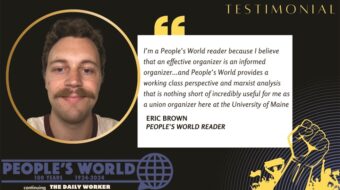
PAUL, Minn. – International Women’s Day occurred last month, and in news stories, public rallies and social media campaigns, advocates drew needed attention to the stubborn gap between wages earned by men and women worldwide.
But there is one area of the U.S. economy where the gap is uniquely narrow: Construction.
On average, women working in the construction trades earn about 96 cents for every dollar men earn. That’s miles ahead of the economy as a whole, where women earn 81 cents on the dollar, and women of color fare even worse. Unionized women earn 89 cents for every dollar the union man earns, and both earn at least $200 weekly more than non-union workers.
“The one great thing about the roof is it doesn’t discriminate against anyone,” Roofers and Waterproofers Local 96 organizer Tristan Lundblad said. “The wage scale is the same for everyone, and no one judges you about anything except whether you work hard.”
Experts have long argued that adding more women to the construction workforce would help reduce broader pay disparities, but efforts to attract more women have seen limited success. Today, about 3 percent of construction tradespeople nationwide are women, and the rate hasn’t changed much over the last decade.
“One of the big factors in women’s lower earnings is they tend to work in occupations where many other women work,” said Ariane Hegewisch, who studies employment and earnings at the Institute for Women’s Policy Research.
“Women’s underrepresentation in construction has an impact on women’s earnings and their poverty rates.”
Why aren’t more women pursuing careers in the trades? In the Twin Cities area, at least, it’s not for lack of outreach from construction unions.
Lundblad was among more than a dozen union-affiliated recruiters at an event for women interested in exploring construction careers, held March 6 in St. Paul as part of Women in Construction Week. Their pitch was familiar – middle class wages and earn-while-you-learn apprenticeship training, first-class health benefits and retirement security – but most chairs in the union hall remained empty.
“We definitely need women,” Tim Grimm said of his union, Local 110 of the International Brotherhood of Electrical Workers. “We are begging for women.”
Attracting sisters into the brotherhood is about more than increasing the local’s diversity, Grimm explained. The construction workforce is aging, and unions aren’t going to meet the demand for skilled workers if they ignore half of the potential workforce.
Women also are vital to Minnesota construction contractors’ ability to capture market share. The state considers “workforce participation goals” for women as part of its process for awarding public construction contracts over $100,000, and those goals jumped sharply last July, from 6 percent to 20 percent in Ramsey (St. Paul) and Hennepin (Minneapolis) Counties.
Meeting new goals will require union contractors and apprenticeship programs to keep hustling to recruit and retain women, but there are challenges associated with both.
For starters, too many women and girls dismiss construction as a career path, or never even consider it. Tasha Lawrence, a member of St. Paul Plumbers Local 34 and vice president of the National Association of Women in Construction (NAWIC), put it this way: “A lot of women don’t know what they want to do, but they know they don’t want to be a plumber.”
Many children are steered toward “gender-specific” activities at a young age, Hegewisch said, and building things falls squarely in the realm of male activities. Research shows shop classes in high school too often are taught in ways that “put off” female students, she added.
And while policymakers have pushed initiatives to increase interest in science and technology among girls, the subsequent step is usually a push toward “college, college, college,” Lawrence said.
Minnesota’s building trades unions have been proactive in developing “youth build” programs that welcome girls into their training centers, pre-apprenticeship programs that connect women with contractors who are eager to hire, and stronger relationships with area high schools – a particularly good idea, Hegewisch said, pointing to research showing most career counselors have little familiarity with the construction industry. “Career counselors exposed to the construction industry are more likely to point girls into construction careers,” she said.
Retaining women construction workers, meanwhile, means addressing the factors that deter women from pursuing jobs in the trades, including the industry’s culture. “Men act a little differently” when women are on the job site, Lawrence said, adding some women feel intimidated, unwanted or out of place.
Hegewisch, who surveyed tradeswomen from across the country for a 2015 report, said workplace harassment remains a problem in the industry. But she pointed to other, more subtle ways job sites could change to become more welcoming to women, like providing equipment that fits and bathrooms that offer privacy.
“Too often on a construction site they get the harness in two sizes, and they’re two or three sizes too big for most women,” Hegewisch said. “Work gloves are much harder for women to find in their sizes too… It feels like an insult, like they don’t really want me here.”
Promoting women to leadership positions – and ensuring they get equal access to job opportunities – helps keep apprentices and tradeswomen in the industry, Hegewisch said, as do mentorship programs and networking groups like NAWIC.
For Lawrence, just being able to see women wearing a hardhat or tool belt, swinging a hammer or pouring concrete helps change the industry’s culture – and its perception – in an organic way.
“I don’t want to sit behind a desk. I’m not a pencil pusher,” she said. “I’m just as capable as men to do the work, and I know I’m not alone.”












Comments